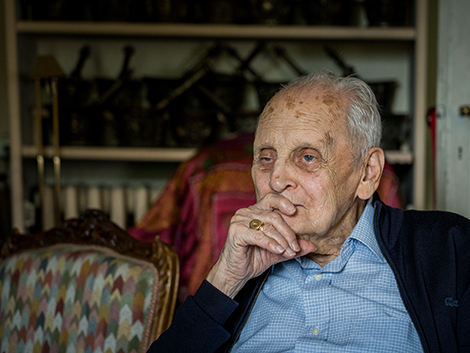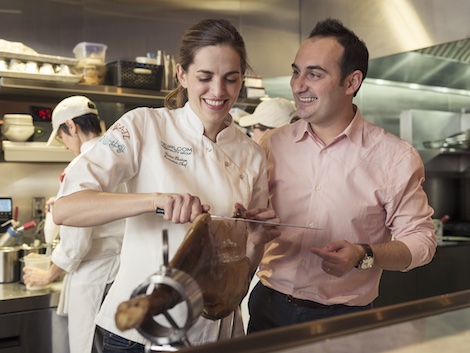Huetz de Lemps: the man who documented the vineyards of Spain’s northwest

Wine epiphanies usually involve a bottle or a breathtaking landscape. In my case, reading played a big part. Vignobles et vins du Nord-Ouest de l’Espagne, the dissertation of Alain Huetz de Lemps which I discovered more than 20 years ago in José Peñín's library, my first boss and mentor in the wine industry, captivated me like no other.
Huetz de Lemps belongs to a generation of French scholars for whom geography and history go hand in hand and who understand wine within a changing context that takes into account the landscape, its people, the laws that govern it and the trade.
Whilst this multidisciplinary approach turns wine into an exciting window on the world, the depth and detail of his descriptions, valley by valley and village by village, reveal the wealth and diversity of Spain's northwestern vineyards. The fact that Vignobles et vins du Nord-Ouest de l’Espagne is now translated into Spanish and reprinted by Cultura Líquida, the foundation of Alma Carraovejas, has brought to light the exhaustive work of the now nonagenarian geographer who tirelessly explored this area of Spain during the 1950s and 1960s to publish one of the best and most thoroughly documented accounts ever written about Spanish wine.
In the foreword of Ludger Mees's El Médoc Alavés, a reprint published by Cía de Vinos Telmo Rodríguez, Pablo Eguzkiza said that their curiosity, inquisitiveness and non-conformism was further stirred with the book. "It spurred us to venture out of our home in search of unique landscapes and forgotten vineyards". Cristina Alcalá, head of the Cultura Líquida foundation, who has spent long hours with Huetz de Lemps working on the new edition, was struck by the painstaking detail of the descriptions of vineyards that no longer exist. For his part, Pedro Ballesteros MW suggests looking beyond the descriptive appearance of the book. "It is a treasure-trove of ideas for observant and discerning readers who will find clues to write future chapters of the wines from Spain."
For me, it was a real pleasure to finally meet Alain Huetz de Lemps and spend some time with him and his wife Nicole Méndez during their short stay in Madrid to present the book. Nicole was born in Madrid to a French mother and a Spanish father. A happy coincidence in life, she met Alain in the same little French coastal village near Biarritz where her parents saw each other for the first time. Alain was about to start his Spanish adventure and she proved to be an essential contributor and a great support with his written dissertation.
On the road
In the 1950s, Spain could hardly afford any comparisons. Alain found a "ruined and backward" country compared to France, which had quickly recovered from the war and was technically more advanced. When he arrived, the Casa de Velázquez, the French cultural institution dedicated to Hispanic studies for which he had won a two-year scholarship, had yet to be rebuilt after being seriously damaged during the Civil War.
Throughout this stay and during the years he worked as an assistant at the Humanities College in Bordeaux (1953-1967), Huetz de Lemps explored the villages and towns of northern Spain in his Renault 4/4 while struggling with the notoriously bad roads. At first, he travelled alone or with Spanish colleagues eager to discover his own country. Many of whom would later become prominent professionals like Jesús García Fernández, a Professor of Geography at the University of Valladolid. "I benefited from the friendship of young geographers rather than historians; they were the best partners to discuss Spanish vineyards. Together we discovered, for instance, the outstanding past of Rueda wines," recalls Huetz de Lemps.
After his marriage -Nicole still remembers the curiosity that their arrival aroused in many small towns-, she also became a regular companion.
Huetz de Lemps limited the scope of his dissertation to the northwest of the country (Galicia and the Cantabrian coast, the Duero valley and the upper Ebro valley). While he had always had great interest in the Mediterranean basin (in fact, his first choice of study was Algeria), professor Roger Dion, the well-known author of Histoire de la vigne et du vin en France: des origines au XIXème siècle, encouraged him to follow in his footsteps in Spain and deepen the knowledge of these tremendously ancient vineyards, which were practically unknown to the French.
According to Huetz de Lemps, Dion excelled at showing that history and geography are indissociable, "because geography largely explains history and history is largely conditioned by geography". This idea emerges in every page of his book as it encompasses a descriptive (location, climatic conditions and diversity of vineyards) and a historical section plus a third segment focused on grape growing, wine production, consumption, social structures, land ownership and trade.
By way of example, Huetz de Lemps points out that the wines of Castille "reached their maximum splendour during the 16th, 17th and 18th centuries due to political reasons as the whole region developed around the royal power and winemakers tried to produce the best quality", or the way in which Galician vineyards developed to supply the city of Santiago de Compostela. "During the Middle Ages", he adds, "all the monasteries grew vines or had vineyards associated to them and when this was not possible for climatic reasons, a wine trade route was quickly organised."
Immersion
Having access to historical information was not always easy. Méndez recalls her particular classification of the archives as "perfectly organised", such as those of Simancas, Valladolid or the Historical Archive of Madrid, and other, more chaotic ones in which they nevertheless managed to find documents of great interest.
"Spain has been an extraordinary country from an administrative point of view and was ahead of the rest of Europe in terms of organisation, thanks to royal, provincial and local power. All the major surveys, even before the one conducted by the Marquis de la Ensenada [1749], which can be regarded as modern, are exemplary and extremely detailed with regards to vineyards and production," Huetz de Lemps points out.
The vast amount of data he compiled during those years and the painstaking detail of his texts are highly valuable and reveal systematic on-the-ground efforts that spanned well over a decade. The book also provides a complete description of the wine growing landscape of the 1960s, just before the arrival of a gradual yet inexorable technological transformation. It includes precise information on the size of the vineyards, their location, extent in relation to other crops and, frequently, the grape varieties grown in each area. In addition to his travels and documentary research, Huetz de Lemps sent questionnaires to over 1,900 villages and had responses from more than half of them.
Huetz de Lemps's work also evidences the evolution that has taken place in the course of half a century, both in terms of the loss of vineyards and the rise of wine regions that seemed doomed to failure in the 1960s, such as Ribera del Duero, Ribeira Sacra or the vineyards of Gipuzkoa, with barely 30 hectares under vine when the book was published.
A comparison between the regions described by the French geographer and today’s DOs is just as interesting. As Huetz de Lemps himself points out, "appellations are often the result of administrative rather than oenological delimitations because those drawing the boundaries are not familiar with the vineyards or because DOs are the result of a compromise between the vineyards, their value and political interests."
At 95, he still believes that growing vines is an extremely delicate activity. "Grapes are not like other crops; they cannot be compared to potatoes, for instance, because the resulting produce does not have the same importance. Vineyards have an extraordinary range of possibilities," he says.
One thousand copies
Huetz de Lemps presented his dissertation at the Sorbonne in April 1967 and was awarded the distinction of Très Honorable. One thousand copies were published with the help of a small printing house in Bordeaux which employed a Spanish operator who faithfully reproduced the Spanish names and toponyms. By then, Huetz de Lemps was 40 years old. From then until his retirement in 1995, he worked as Professor of Human and Rural Geography at the University of Bordeaux. His work has served to substantiate the historical foundations of several Spanish appellations of origin.
In 1999 he was awarded an honorary doctorate by the University of Valladolid. A few years later, the Junta de Castilla y León, through the Fundación Castellano Leonesa para la Cultura del Vino (Castilla y León Foundation for Wine Culture), translated and partially printed the part of the book covering its territory. It was published in 2004 as Vinos y viñedos de Castilla y Léon. As the original edition was out of print, I have been using this book in recent years, except for temporary loans from friends or consultations at the Documentation Centre of the Vivanco Foundation in Briones (La Rioja).
I sense that, in these days of English language dominance in wine communication, French publications have been pushed aside. As far as I know, British and American specialists in Spanish wine usually rely on English sources. Hence the importance of Cultura Líquida's initiative to finally translate the complete text into Spanish and make it available to scholars and wine enthusiasts. The release was accompanied by a warm recognition by the Spanish wine industry. Huetz de Lemps was awarded the Life Achievement Award at the IWC Merchant Awards Spain and was greeted with a long, enthusiastic applause during the presentation of the book at Madrid's Atheneum.
I share Cristina Alcalá’s opinion that he produced a modern, contemporary work that continues to be a great read in 2022. “Spain is best known throught the eyes of Huetz de Lemps,” she says.
One thousand copies of the book have been printed. As in the original edition, it consists of two volumes with all indexes grouped at the end of the second volume. It can be bought on the website of Fundación Cultura Líquida for €95. It is bigger in size and the hardcover is lined with fabric, but I can’t help dreaming of a paperback edition for a book I refer to so often. I love coming back from trips to regions described in the book and check what Huetz de Lemps wrote about them.

Amaya Cervera
A wine journalist with almost 30 years' experience, she is the founder of the award-winning Spanish Wine Lover website. In 2023, she won the National Gastronomy Award for Gastronomic Communication
Wine tastings in February 2022
NEWSLETTER
Join our community of Spanish wine lovers






